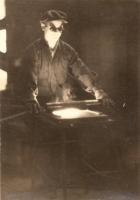Glassmaking in Bryn Athyn
 Bryn Athyn, Pennsylvania, was founded as a religious community in the late 19th century by members of a Christian denomination known as the New Church. It is home to some of the area’s most remarkable architecture, buildings that reflect the religious faith of the community’s earliest residents.
Bryn Athyn, Pennsylvania, was founded as a religious community in the late 19th century by members of a Christian denomination known as the New Church. It is home to some of the area’s most remarkable architecture, buildings that reflect the religious faith of the community’s earliest residents.
Ground was broken for Bryn Athyn Cathedral in 1913. At first the cathedral’s architect was Ralph Adams Cram, the country’s leading proponent of Gothic Revival architecture. However, Cram’s involvement with the project ended in the spring of 1917, leaving Raymond Pitcairn, a lawyer with no formal training in architecture, fully in charge of both construction and design. The cathedral is renowned for the old world craftsmanship used to create its medieval style architecture and magnificent stained glass windows. The subject matter of the windows is based entirely on New Church (Swedenborgian) teachings. However, Pitcairn, who supervised its construction, was determined to duplicate the textures and pure colors of the medieval glass he admired in the churches of Europe. This would prove to be a monumental undertaking. In prewar, industrialized America, the art of making hand-blown glass had virtually disappeared. To achieve the quality he was looking for, the Bryn Athyn studio had to do no less than rediscover the lost techniques of the medieval glassmakers. Pitcairn arranged for a translation of a manuscript in Latin by Theophilus, a 12th century German monk who had described the art of stained glass making. He also sent his artists to France and England to draw and photograph the stained glass windows in the churches there, and established a glass studio and furnace in Bryn Athyn.
However, it was clear from the very beginning that for their experiments to make progress the Bryn Athyn glassmakers would need hands-on access to actual medieval windows. Their opportunity came in 1921, when the Henry C. Lawrence collection was put on the auction block in New York City. For three days in January, the saleroom of the American Art Association was packed with museum directors, dealers, and collectors. The competition was fierce, but the bidding for the best thirteenth century windows became a duel between Pitcairn, a complete stranger in collecting circles, and the legendary art dealer Joseph Duveen. In the end, to the astonishment of everyone in the room, Pitcairn refused to be outbid, and came away with twenty-three panels of medieval glass. News of the high prices paid at the sale spread quickly, and the event received significant coverage in the press. On a single day, Raymond Pitcairn had gone from being virtually unknown in the art world to being a collector of international importance.
As progress continued on Bryn Athyn Cathedral, Pitcairn expanded his stained glass purchases, and in time his collection would grow to include more than 260 panels. According to Philippe de Montebello, Director of the Metropolitan Museum of Art, “The Romanesque and Gothic art that was assembled by Raymond Pitcairn in the early part of this century represents the world's finest and most extensive collection of medieval sculpture and stained glass still in private hands” (Hayward, Jane and Walter Cahn, with Peter Barnet et. al. Radiance and Reflection: Medieval Art from the Raymond Pitcairn Collection. New York: Metropolitan Museum of Art, 1982, p. 4).
As the Cathedral project began to wind down in the late 1920s, the designers, artists and craftsmen began turning their attention to an exciting new building project: the construction of Glencairn, the Pitcairn’s castle-like home. In 1929, when excavation for the foundation of Glencairn had already begun, America was struck by the Great Depression. Digging stopped and the foundation hole was partially filled in while Pitcairn decided what to do. This must have been an anxious time for the artists and craftsmen in particular, who knew they would have almost no other chance of finding work in their chosen professions. Pitcairn reopened the project a few months later, though at a much slower pace. Construction on Glencairn was to continue throughout the 1930s, providing employment to more than 100 men. Visitors who explore Glencairn are met with a wealth of images in stone, wood, stained glass and mosaic—created by Bryn Athyn craftsmen, and inspired by the teachings of the New Church.